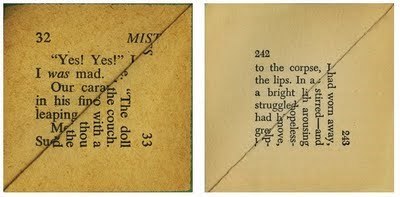In the Corners

A poet with the visual word is someone who see text that other people never even imagine seeing. So is Erica Baum, whose new book, Dog Ear, just out from Ugly Duckling Presse, captivates with its visual presence and with its outré expectations about reading.
What this book is is something simple and beautiful, something shudderingly mind-changing in the smallest of ways. Maybe it is that I have stared at text with awe and passion too long in my life to make a reasoned judgment of such a work, but I think what I see is what others see, or at least should.
Baum, who is the tree from which the pages of this book is made, who is the tree of the pages of many book from which the pages of this book is made, does something very simple in this book, something no-one saw before, but something that brings the world suddenly into hyperfocus. For all that Baum has done is rifle through paperbacks dogearing the pages until the effects of the dogeared overlap lying onto the page behind it create some kind of poetry.
Poetry is always hidden from us, and only the poet can find what we cannot see. The features of these foldings that are amazing and many in number. The lines of the perfect equilateral triangle of the corner turned over always line up with the lines of the pages behind it, so lines going vertical feed into lines going horizontal, and we read as if the line is a right angle of sense. And these right angles make some kind of unexpected sense when we read across those angles. All of these bent-over corners are presented to us as enlarged squares of text, with perfect margins around their entirety (and sometimes with page numbers), and this size allows us to see the details of the text, the typefaces, and even the paper, which ranges wildly in color, from almost white to a cocoa brown. These are visual texts, texts that exist only in this manner on single copies of books we'll never see the originals of. But they captivate through their physicality nonetheless.
I could talk about the poetry of these works, but the book sandwiches these squares of beauty between two separate expanses of text that try to illuminate these for us. That is impossible. Take away the introduction. Take away the postface. They are fine. But unnecessary. Find these squares and see them. Find these squares and read them. In full color.
The simplicity of the greatest beauty is that we are surprised they have always been with us.
Erica Baum has saved us from our blindness.
_____
Baum, Erica. Dog Ear. Ugly Duckling Presse: Brooklyn, N.Y., 2011. US$20 (direct from the publisher)
ecr. l'inf.
Published on May 30, 2011 20:23
No comments have been added yet.



